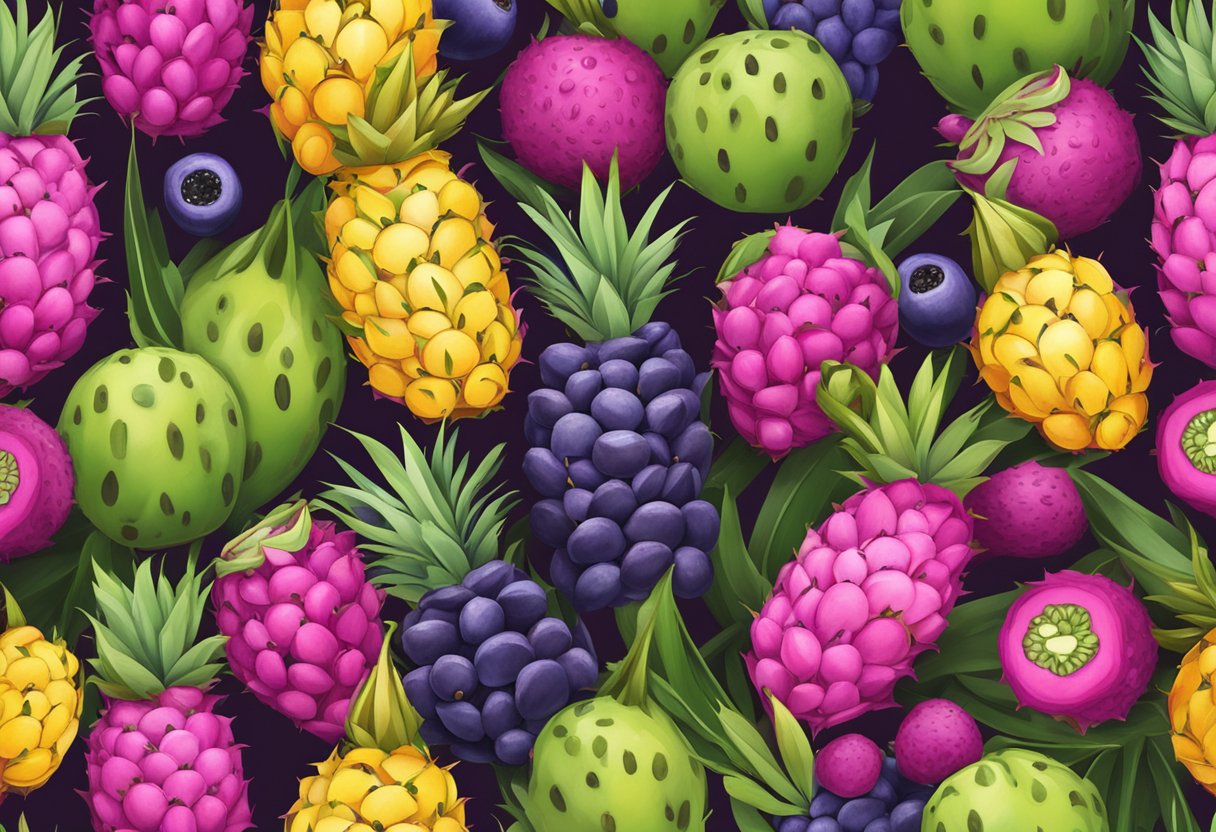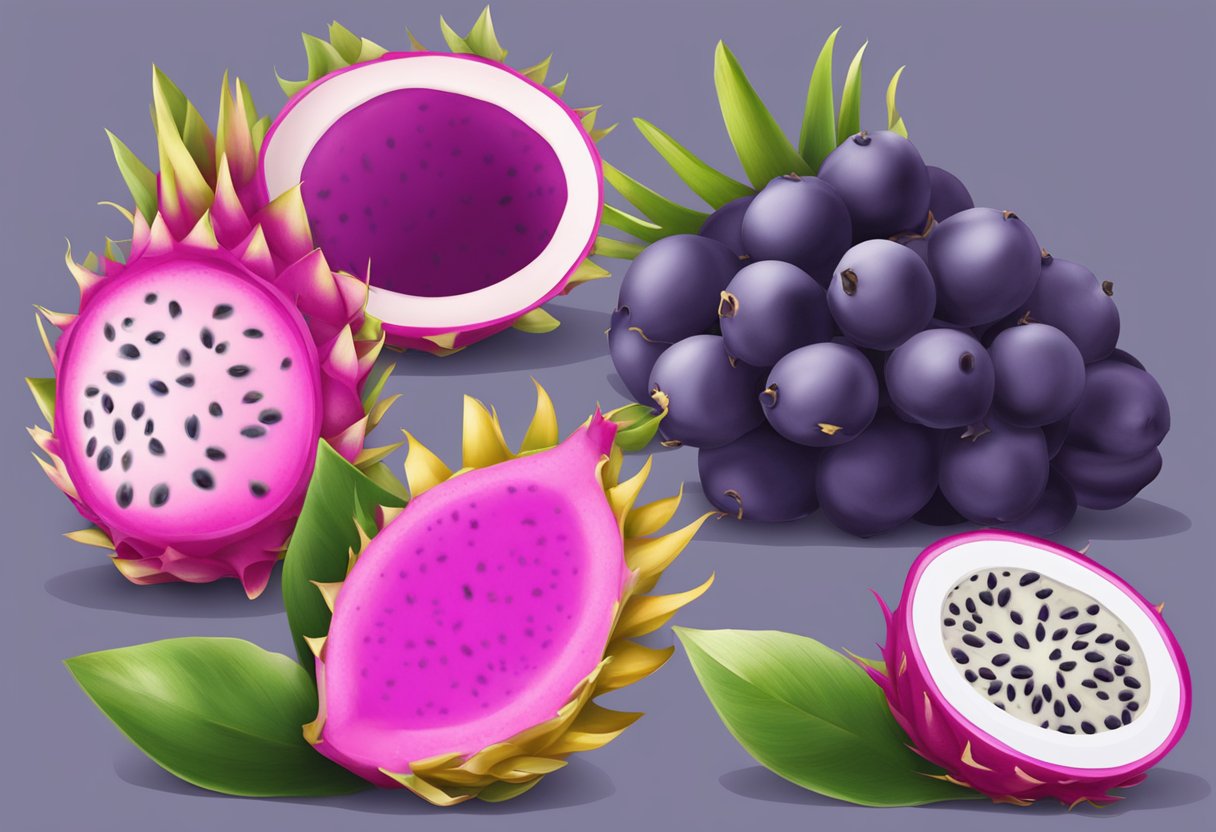Pitaya and acai have taken the world by storm, with their vibrant colors and impressive health benefits. These two tropical fruits have become popular ingredients in smoothies, bowls, and desserts. While they may seem similar, there are distinct differences between pitaya, also known as dragon fruit, and acai berries that can impact flavor, nutrition, and enjoyment.

Originally from Mexico and Central America, pitaya is a brightly colored fruit with a unique taste. In contrast, acai berries are small, grape-like fruits native to the Amazon rainforest in Brazil. Both fruits are rich in nutrients, but they possess distinct flavors, appearances, and nutritional profiles. There are several factors to consider when deciding which of these superfruits to incorporate into your diet.
Key Takeaways
- Pitaya and acai are two popular tropical fruits with distinct origins, flavors, and nutritional contents.
- Both fruits can be enjoyed in various forms and dishes, allowing for personal preference.
- Choosing between pitaya and acai may depend on factors such as taste preference, nutritional goals, and availability.
Pitaya and Acai: A Brief Overview

Pitaya and acai are two remarkable tropical fruits that have gained significant attention in recent years, particularly for their potential health benefits. As a result, they have earned the titles of “superfood” and “superfruit.” This section will provide a concise and clear overview of these two tropical fruits, focusing on their origins, nutritional profiles, and potential health benefits.
Pitaya, commonly known as dragon fruit, is a fruit native to Central America and Mexico and is part of the cactus family. There are several different varieties, with the most common being red and white. Pitaya has a unique appearance, featuring a vibrant outer skin with a speckled, edible inner flesh. Its flavor is often described as mildly sweet and refreshing.
Acai, on the other hand, is a small, dark purple berry native to South America, primarily found in the Amazon rainforest. Acai has gained immense popularity, especially in the United States, due to its inclusion in various health food products such as smoothie bowls, supplements, and juices. The taste of acai is often compared to that of a mix between berries and chocolate.
In terms of nutrition, both pitaya and acai are rich in antioxidants, which help combat free radicals and support overall health. Acai is notably high in anthocyanins, a powerful antioxidant that gives the berry its deep purple color. Additionally, acai contains healthy fats and dietary fiber, while being low in sugar. Pitaya also boasts a solid nutritional profile, being a good source of vitamins and minerals such as vitamin C, calcium, and iron.
Although both fruits are touted as superfruits, consumers should approach their potential health benefits with a balanced perspective. While pitaya and acai do offer an array of valuable nutrients, they should not be viewed as miracle solutions to health problems. Instead, they can be incorporated into a varied and balanced diet to provide an added boost of nutrients and antioxidants.
In conclusion, both pitaya and acai have garnered well-deserved attention as tropical superfruits due to their unique flavors, appealing appearances, and impressive nutritional profiles. Incorporating them into one’s diet can serve as a delicious and nutritious way to enhance overall health and wellbeing.
The Origin of Pitaya and Acai

Pitaya, also known as dragon fruit or strawberry pear, is a medium-sized, oval-shaped tropical fruit native to Mexico, Central America, and Southeast Asia [^3^]. The most common variety of pitaya has magenta-colored skin with pointy green scales, which gives it the name “dragon fruit.” This stunning fruit is found predominantly on cactus plants [^4^].
On the other hand, acai berries are native to the Amazon rainforest of Brazil, particularly in the northern region of the country [^5^]. Acai berries have a grape-like appearance and grow on acai palm trees, which are commonly found in South American rainforests, especially in Brazil [^2^]. These remarkable berries have been used for centuries due to their nutritional and medicinal properties.
Both pitaya and acai gained popularity as superfoods in recent years. The origin of these fruits clearly demonstrates that they come from different parts of the world and belong to different plant families. Pitaya thrives on cacti in a wide range of environments across Mexico, Central America, and Asia, while acai berries are highly concentrated in the dense Amazon rainforest, growing on the tall and slender acai palm trees. The environments these fruits grow in contribute to their unique characteristics and nutritional profiles, making them sought-after ingredients for health-conscious individuals.
Appearance and Taste

Pitaya and acai are both tropical fruits known for their vibrant colors and unique flavors. The Pitaya, also known as dragon fruit, has a bright pink or yellow exterior, with white or pink flesh dotted with tiny black seeds. Its taste is often described as a cross between a kiwi and a pear, offering a blend of sweet and slightly sour flavors. The texture of pitaya is similar to that of kiwi as well, with a soft, juicy flesh.
On the other hand, acai berries have a distinctive dark purple to blackish color. They are smaller in size, closely resembling a large grape. Acai has a slightly tart, sweet taste, which some people compare to that of red berries or dark chocolate. The acai berries’ texture is relatively smooth and velvety, with a small seed inside each berry.
When comparing the sweetness of both fruits, pitaya is generally considered to be sweeter than acai. While acai berries have a natural sweetness, their tartness tends to be more dominant in their flavor profile. Pitaya, with its kiwi and pear-like taste, presents a more subtle sweetness that is often preferred by those who enjoy milder fruity flavors. Since both fruits can be used in similar ways, such as smoothie bowls and juices, the choice between them often comes down to personal taste preferences and the desired level of sweetness.
In conclusion, both pitaya and acai have their own unique appearances, taste, and sweetness levels. With their bold colors and flavors, they each offer a refreshing and nutritious addition to a variety of culinary creations.
Nutritional Content and Health Benefits

Pitaya and Acai are both known for their nutritional content and health benefits. They are rich in vitamins, minerals, and antioxidants, which contribute to overall health and wellbeing.
Pitaya, also known as dragon fruit, is a good source of vitamin C, calcium, and iron 1. It also contains a slightly higher amount of potassium compared to Acai. The fruit is high in fiber, which is known to support digestive health and help maintain healthy blood sugar levels.
Acai, on the other hand, has significantly more vitamin A and also contains more vitamin C, calcium, and iron compared to Pitaya 2. Acai berries are particularly high in antioxidants, which are vital for boosting the immune system and protecting the body against free radicals.
In terms of protein, both of these superfruits contribute a small amount to the diet. However, the benefits they provide mainly stem from their vitamins, minerals, and antioxidants.
Here are some specific health benefits linked to Pitaya and Acai:
- Cardiovascular Health: Acai contains healthy HDL fats that support heart functioning 3. Studies have shown that HDL can reduce the risk of cardiovascular disease by up to 3%.
- Energy: Both Pitaya and Acai are natural sources of carbohydrates, providing essential energy for the body. However, Pitaya contains nearly three times more carbs than Acai 4.
- Immune System Support: The antioxidants present in Pitaya and Acai help to strengthen the immune system by fighting harmful free radicals.
- Bone Health: Both fruits are good sources of calcium and magnesium, which are essential minerals for maintaining strong bones.
When it comes to taste, Pitaya is slightly sweeter and resembles a watermelon taste, while Acai has a flavor similar to blackberries 5. The choice between the two fruits may ultimately come down to individual taste preferences and nutritional needs.
Taste and Preference

When it comes to taste and preference, both pitaya and acai have their unique flavors and textures that might appeal differently to various palates. Pitaya, also known as dragon fruit, has a mildly sweet taste that is somewhat akin to a combination of kiwi and pear. Its texture resembles that of kiwi with tiny, crunchy seeds embedded in the juicy and refreshing flesh. Acai, on the other hand, has a rich and slightly tart flavor, often compared to a mixture of berries and chocolate. The texture of acai is smooth, with seeds found in the center of the fruit.
When consumed in different forms, the taste and texture of both fruits can vary significantly. For instance, the use of frozen or fresh fruit, as well as their puree or powder versions, can influence the overall flavor and mouthfeel in smoothie bowls, juices, or snacks. While using frozen puree or fresh fruit can help retain the natural taste of pitaya or acai, incorporating powder or juice forms might result in slightly different flavors that cater to specific preferences.
It is not unusual to find fruit blends that include banana, either as a base for smoothie bowls or as a complementary ingredient in snack bars. The addition of banana to pitaya or acai can enhance the creaminess and sweetness, leading to a more satisfying experience. Balancing the flavors with other fruits can further enrich the taste, allowing individuals to personalize their dishes or drinks based on their preferences.
In summary, the taste of pitaya and acai depends on the form and combination of ingredients, along with an individual’s personal preference. While some might find the subtle sweetness of dragon fruit more appealing, others might lean towards the bolder flavors provided by acai. Ultimately, experimenting with various forms, such as frozen or fresh juice, powder, or puree, can help consumers discover their preferred taste and texture when enjoying these superfruits.
Ways to Enjoy Pitaya and Acai

Pitaya and acai berries are both popular fruits that can be enjoyed in various ways. They are often used in smoothies, breakfast bowls, and even desserts, providing not only a delicious taste but also a range of health benefits.
One popular way to enjoy both pitaya and acai is by making a smoothie. To create the perfect pitaya or acai smoothie, simply blend the fruit with your choice of milk, ice, and additional fruits. This will result in a thick, creamy, and nutrient-dense beverage that is perfect for breakfast or to satisfy your sweet cravings in a healthy way.
Another great way to enjoy these fruits is by making a smoothie bowl for breakfast. To create a pitaya bowl, blend pitaya with other fruits such as bananas, strawberries, or mangoes, and mix in a little milk or yogurt. Pour this mixture into a bowl and top it with sliced fruit, nuts, seeds, or granola for added texture and flavor. The same can be done with acai berries to create an acai bowl, which often includes additional ingredients like spinach or kale for an added nutritional boost.
While smoothies and smoothie bowls are common ways to enjoy pitaya and acai, there are also some differences in how these fruits can be incorporated into desserts. Acai berries, for example, can be blended into a sorbet or a frozen dessert, providing a refreshing, unique, and nutritious treat. Pitaya, on the other hand, is often used as a topping or garnish on desserts like cakes, tarts, or puddings, adding a beautiful and vibrant touch to the dish.
In conclusion, pitaya and acai berries offer various options for incorporating their delicious flavors and health benefits into your daily meals. Whether it’s through smoothies, breakfast bowls, or desserts, these fruits can provide a tasty and nutritious addition to your diet.
Choosing Between Pitaya and Acai

When comparing pitaya and acai, it’s important to consider their nutritional content, flavors, and how they can fit into one’s diet. Pitaya, also known as dragon fruit or strawberry pear, is a tropical fruit native to Mexico and Central America source. On the other hand, acai berries are small purple drupes that grow on the acai palm tree in South America.
In terms of nutrition, both fruits are rich in essential vitamins and minerals. However, there are some differences in their calorie and macronutrient content. Pitaya is generally lower in calories, with around 60 calories per 100 grams, while acai berries contain about 70 calories per 100 grams source. Pitaya has a lower fat content, making it a better option for those aiming to consume fewer calories. In contrast, the healthy fat in acai berries is beneficial for heart health and overall well-being source.
When looking at sugar content, pitaya contains slightly less sugar than acai berries, with 8-13 grams of sugar per 100 grams, while acai has 15-22 grams per 100 grams source. This difference may be relevant for individuals following a keto or low-sugar diet. Nonetheless, both fruits have relatively low sugar content compared to other common fruits.
The flavor of the two fruits is another important factor to consider. Pitaya has a mildly sweet flavor and a juicy texture with crunchy seeds, similar to a kiwi or watermelon. Acai berries, on the other hand, have a more tart flavor with a hint of dark chocolate. Choosing between the two fruits can come down to personal taste preferences.
Both pitaya and acai offer a variety of health benefits, such as promoting heart health, aiding digestion, and potentially helping to lower cholesterol levels. However, as with any food, it is essential to consume them in moderation and as part of a balanced diet.
In conclusion, when choosing between pitaya and acai, one should consider their specific dietary needs, taste preferences, and desired health benefits. Both fruits are nutrient-dense and can make great additions to smoothies, parfaits, or breakfast bowls.
Availability of Pitaya and Acai

Pitaya, also known as dragon fruit, is a tropical fruit native to Central America and Southeast Asia, with its distinct appearance of magenta-colored skin and pointy green scales. Acai, on the other hand, originates from the Amazon region in Central and South America. Both of these fruits can be found in countries within their respective native regions, but their availability may vary in other parts of the world.
In the United States, pitaya and acai are increasingly becoming popular for their numerous health benefits and unique flavors. As a result, they can be found in several grocery stores and specialty markets, especially in freeze-dried or frozen form. Fresh pitaya and acai may be more challenging to come across outside of their native regions due to their delicate nature and short shelf-life.
Pitaya is available in two main varieties: red and yellow. The red variety is known for its white or red flesh inside, and the yellow pitaya has a sweeter taste with yellow skin on the outside. Acai berries are typically found as dark purple, small, and round fruits, similar in size and appearance to a grape.
While both pitaya and acai are considered tropical fruits, their growing conditions are quite different. Pitaya thrives in warm climates, typically those similar to its native Central America, with plenty of sunlight. In contrast, acai berries are accustomed to the high humidity and shaded canopy of the Amazon rainforest.
In summary, pitaya and acai are both gaining popularity in the US and other countries for their unique flavors and health benefits. While the availability of these fruits outside their native regions might be limited, they can still be found in freeze-dried, frozen, or even powdered forms in various grocery stores and specialty markets. Keep in mind that the availability and condition of fresh pitaya and acai may be much rarer due to their fragile nature and short shelf-life.
Conclusion

In comparing pitaya and acai, we can address several factors, such as nutrients, appearance, texture, and availability of the fruits. Pitaya, commonly known as dragon fruit, is native to Mexico and Central America. Acai, on the other hand, grows in clusters on tall acai palm trees in South American countries like Brazil and Peru.
When it comes to their nutritional profile, both fruits offer an array of health benefits. They are rich in antioxidants, helping support overall well-being and fight off free radicals that could contribute to cardiovascular diseases. However, their specific nutrient compositions may differ slightly, with acai having a stronger nutrient profile in general.
In terms of appearance and texture, pitaya and acai vary significantly. Pitaya has a vibrant pink outer layer and a white or red inner flesh dotted with small black seeds, resembling blackberries. The texture of pitaya is soft and creamy, while acai has a tougher texture, resembling a leather-like consistency. This makes acai more suited for use in smoothie bowls and other blended applications.
For availability, both fruits can be found in frozen fruit form or as a freeze-dried powder. Frozen acai is often used in smoothie bowls, while pitaya is enjoyed in various dishes and smoothies. Acai is more commonly available as a freeze-dried powder, which can be easily added to various recipes and smoothie preparations.
In conclusion, pitaya and acai are both nutritious and flavorful fruits with unique characteristics. They each offer distinct health benefits and differ in terms of appearance, texture, and availability. Choosing between them ultimately depends on personal preferences and desired uses, with no clear winner as both contribute positively to a healthy diet.
Frequently Asked Questions

What are the health benefits of pitaya compared to acai?
Both pitaya and acai are known for their health benefits, as they are packed with antioxidants, fiber, and essential nutrients. Pitaya, also known as dragon fruit, is rich in vitamin C and has immune-boosting properties, while acai berries are known for their anti-inflammatory and heart health benefits source.
How do the nutritional values of pitaya and acai compare?
Pitaya and acai have some differences in their nutritional profiles. Acai berries are higher in iron and calcium, while pitaya is higher in magnesium. Both fruits are high in fiber, but pitaya has slightly more fiber content compared to acai source.
Which has more antioxidants, pitaya or acai?
Acai is considered a superfood due to its exceptionally high antioxidant content. While pitaya also contains antioxidants, acai has more antioxidant capacity, making it more effective in neutralizing free radicals and protecting the body from oxidative stress source.
Are pitaya bowls and acai bowls similar in taste and texture?
Pitaya and acai bowls may look similar and share some overlapping ingredients, but they differ in taste and texture. Acai has a more intense, earthy flavor, while pitaya has a mild, slightly sweet taste. As for texture, acai is often described as silky and smooth, whereas pitaya has a more crunchy texture due to its edible seeds source.
What are the calorie differences between pitaya and acai bowls?
The calorie content of pitaya and acai bowls can vary depending on the ingredients used. However, in general, acai bowls tend to be higher in calories since the acai berry itself has a higher fat content compared to pitaya source. Always keep in mind that the total calories in a bowl will be affected by additional toppings and sweeteners.
Is the sugar content of pitaya higher than that of acai?
Pitaya has a slightly higher natural sugar content compared to acai. However, the difference is relatively small and may not significantly impact the overall sugar content of a bowl, especially if sweeteners or high-sugar toppings are added source. It’s essential to consider the entire recipe when evaluating the sugar content of pitaya and acai bowls.
- PowerBlock Elite EXP Dumbbells Review: Are They Worth It? - November 5, 2024
- On the Edge of a Revolution? Eric Weinstein’s Raw Take on What’s Coming - November 5, 2024
- Why Isn’t Anyone Talking About This? Dr. Eric Berg’s Bold Take on Nutrition - November 5, 2024








